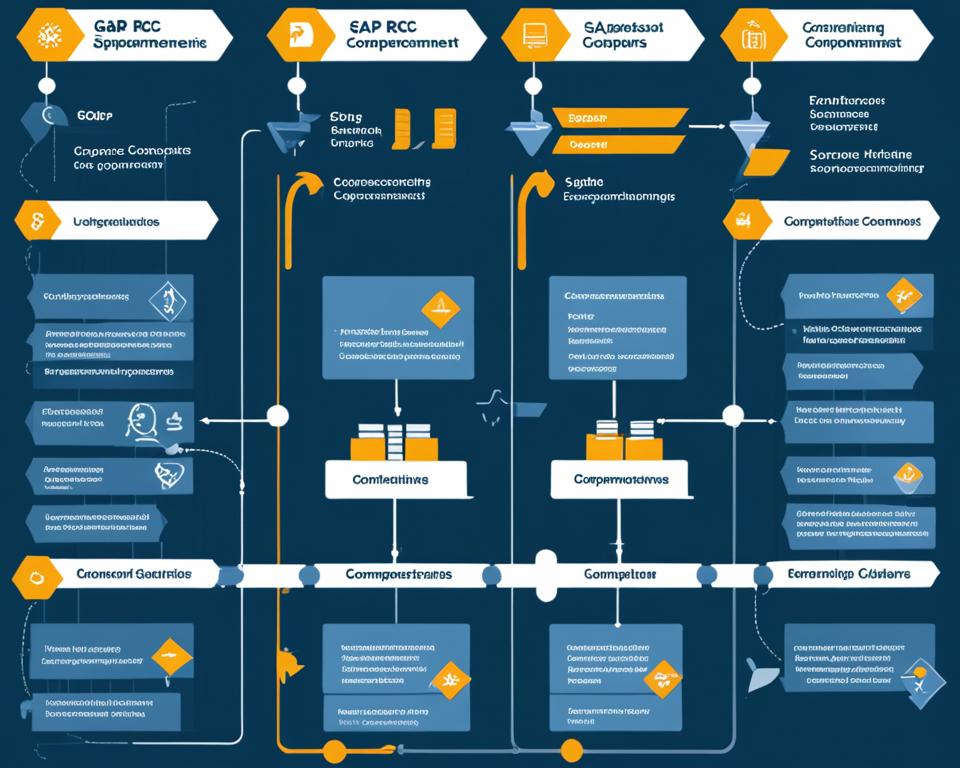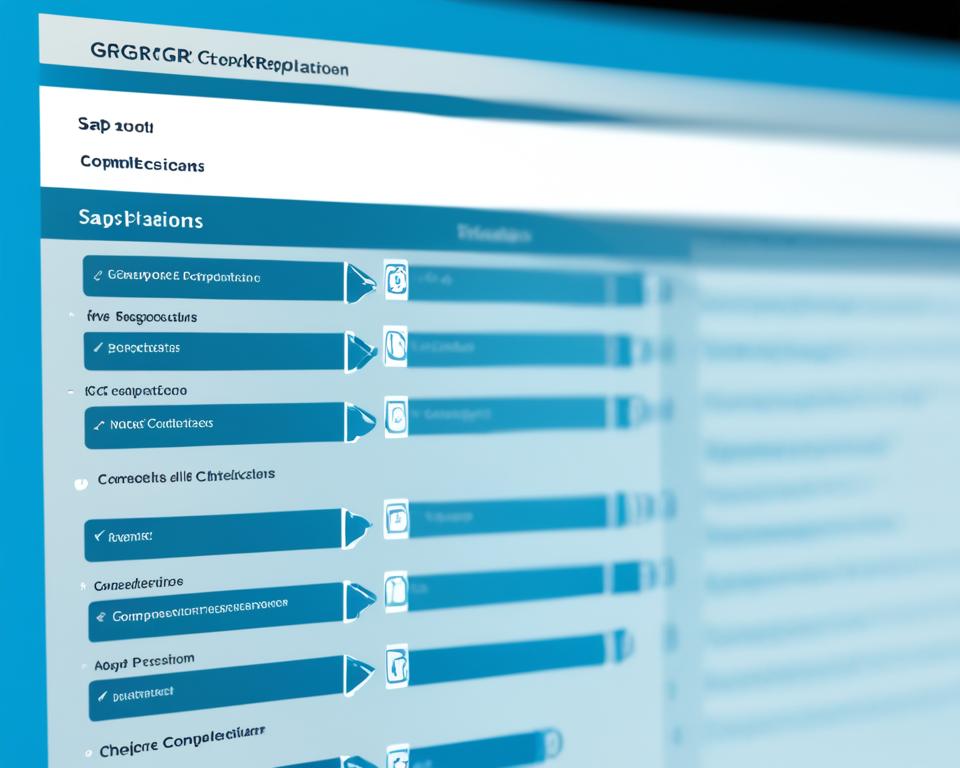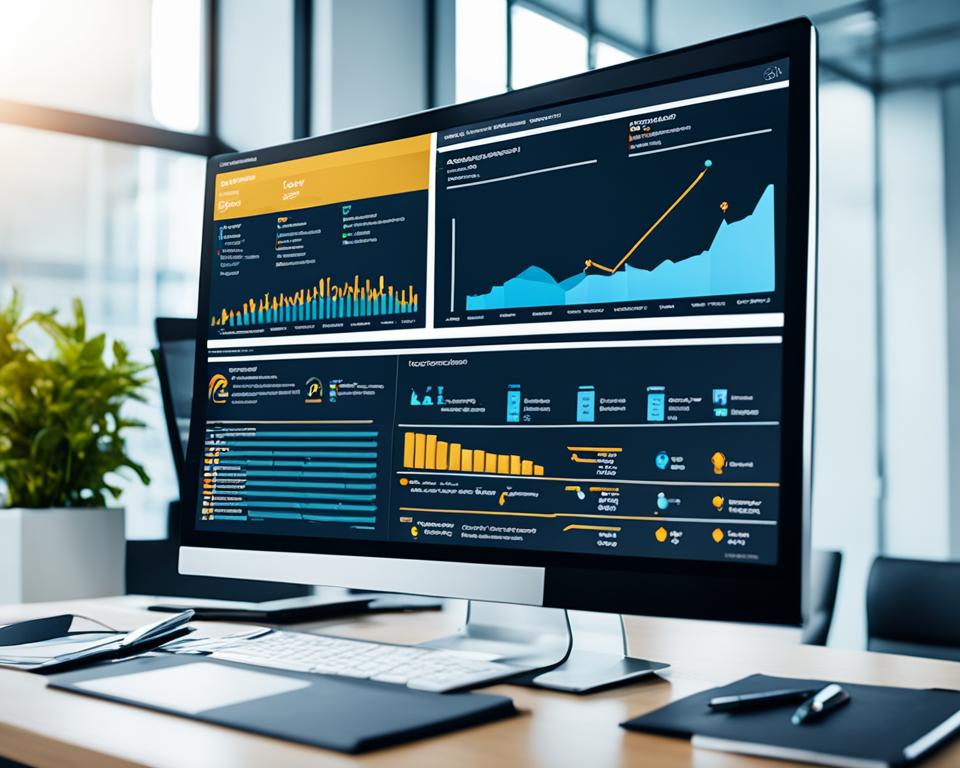Ever thought about how your company can handle risks and follow changing rules? In today’s complex world, managing governance, risk, and compliance is key. SAP GRC offers tools and a framework to make risk management smoother and improve governance. By learning about SAP GRC, your company can face compliance issues head-on and improve internal controls.
Key Takeaways
- SAP GRC is essential for effective governance, risk management, and compliance.
- Implementing SAP GRC helps organizations streamline compliance processes.
- Effective risk management is crucial in today’s regulatory environment.
- Understanding SAP GRC can enhance your organization’s internal controls.
- SAP GRC provides the framework for navigating complex compliance challenges.
Understanding SAP GRC and Its Importance
SAP GRC is key to good governance and risk management in companies. It brings together important processes to help manage risks and follow the law. Knowing how SAP GRC works helps protect companies from risks.
Companies today face many challenges with laws and regulations. SAP GRC helps by offering a way to handle risks and follow the law well. It helps me make smart choices that meet my company’s goals and avoid legal trouble.
Putting governance, risk management, and compliance together in one system has big benefits. With SAP GRC, I can make processes smoother, make things clearer, and make everyone accountable. As laws and rules change, SAP GRC gives me the tools to keep my company successful.
The Components of Governance, Risk, and Compliance
Understanding SAP GRC’s key parts is vital for good business management. Governance, risk management, and compliance work together to make processes smoother. They help align with goals, reduce risks, and follow the law.
What is Governance in SAP GRC?
Governance in SAP sets the rules and processes that match business goals. It makes sure everyone’s interests are considered in decisions. This leads to better accountability and quick responses from organizations.
Risk Management Explained
Risk management in SAP GRC means looking at risks, figuring out their size, and deciding which ones to tackle first. This helps companies protect their resources and keep running smoothly.
The Role of Compliance
The compliance part of SAP GRC is about following the law, rules, and company policies. Keeping detailed records and checking on compliance helps avoid fines and keeps a good name. A strong compliance plan also encourages ethical behavior in the company.

| Component | Description | Benefits |
|---|---|---|
| Governance | Framework for aligning processes with organizational goals. | Increased accountability and transparency. |
| Risk Management | Identification and management of organizational risks. | Minimized impact of potential threats. |
| Compliance | Adherence to relevant laws and regulations. | Avoidance of penalties and reduced legal risks. |
Enterprise Risk Management with SAP GRC
Today, managing risks is key for businesses. SAP GRC helps me set up a strong system for spotting and checking risks across different areas. It’s vital for following rules and making operations smoother.
One big plus of SAP GRC is seeing risks as they happen. This lets me take early steps to lessen threats. With SAP GRC tools, I keep an eye on risks and act fast when needed.
- Risk Identification: First, I look for risks that could hit the company. I use past data and talk to different teams to find them.
- Risk Assessment: Then, I check how likely and big these risks are. I sort them to focus on the biggest worries.
- Risk Response Strategies: Knowing the risks, I make plans to deal with them. This could mean new rules, training, or moving resources around.
- Monitoring and Reporting: Keeping an eye on risks is key. I use SAP GRC’s tools to make reports and track how things are going.
By doing these things, my company can handle risks better and use SAP GRC fully. Adding ERM to our processes helps us make better choices. We’re ready for whatever comes our way.
| Risk Management Component | Description | Importance |
|---|---|---|
| Risk Identification | Systematic process to pinpoint risks that could affect the organization. | Essential for developing mitigation strategies. |
| Risk Assessment | Evaluating risks based on their likelihood and potential impact. | Prioritizes risks for focused management efforts. |
| Risk Response | Formulating and implementing strategies for managing risks. | Allows for proactive risk mitigation. |
| Monitoring | Ongoing evaluation of risk exposure and management strategies. | Ensures timely updates and adjustments to risk plans. |
Regulatory Compliance Made Easy with SAP GRC
Understanding regulatory compliance SAP GRC changes how companies handle their rules. With more rules to follow, it’s key to stay in line. SAP GRC makes this easier by automating tasks, keeping track of law changes, and offering key reporting tools.
Importance of Staying Compliant
Being proactive is key to meeting rules. SAP GRC helps by making things clear and transparent. It has tools that make it easy to check compliance in different areas. This way, I can spot and fix risks early.
Challenges in Regulatory Compliance
Companies often struggle with compliance challenges like complex rules and not enough resources. Keeping up with changes is hard. SAP GRC offers a way to overcome these issues, helping my company stay true to its compliance goals.

| Challenge | Impact on Compliance | How SAP GRC Helps |
|---|---|---|
| Complex Regulations | Leads to potential non-compliance | Automates updates and compliance tracking |
| Resource Constraints | Limits the ability to monitor compliance | Streamlines processes to maximize efficiency |
| Evolving Standards | Causes confusion and lagging response | Provides real-time insights into regulatory changes |
For more on SAP and its programming language ABAP, check out this topic. It’s great for understanding SAP GRC better.
Enhancing Internal Controls
Internal controls are key to protecting an organization’s assets and making sure financial reports are reliable. They act as a system to keep things running smoothly. They help reduce risks and make sure everyone is accountable.
What Are Internal Controls?
Internal controls are a set of rules and practices. They protect assets, follow laws, and make sure financial records are correct. These controls include:
- Segregation of duties to prevent fraud
- Access controls to sensitive information
- Regular audits of financial statements
- Monitoring compliance with internal policies
Having good internal controls keeps stakeholders’ investments safe. It also helps build an ethical work culture.
The Benefits of Strong Internal Controls
Using SAP GRC to improve controls brings many benefits. Here are some key advantages:
- Fraud Reduction: Strong controls cut down the risk of fraud a lot.
- Operational Efficiency: Automation makes processes smoother, boosting productivity.
- Regulatory Compliance: Good controls keep an organization in line with laws.
- Informed Decision-Making: Accurate financial reports support better planning and risk management.
SAP GRC automates internal controls, making it easier to check compliance and adjust to new laws. This technology helps businesses trust the integrity of their operations.
| Feature | Manual Controls | Automated Controls with SAP GRC |
|---|---|---|
| Fraud Detection | High effort, prone to errors | Real-time monitoring, alerts |
| Compliance Monitoring | Periodic reviews | Continuous oversight |
| Data Accuracy | Dependent on human input | High reliability, reduced risk |
| Reporting Speed | Time-consuming | Instantaneous reporting capabilities |
Efficient Audit Management
Effective audit management is key for any organization aiming for top compliance and performance. With SAP GRC for audit management, I can make audit processes smoother. This means better planning, execution, and reporting. It helps me focus on what’s important—spotting risks and making improvements.
Regular audits are vital for keeping up with rules and finding ways to get better. Using automation in SAP GRC cuts down the time and effort needed for audits a lot. This makes audits more efficient and effective. It lets me quickly find weak spots, so my organization can act fast.

Audit management with SAP GRC offers more than just efficiency. It builds a culture of accountability and ongoing betterment. Through regular audits, organizations can boost their compliance and gain trust with stakeholders. Each audit cycle gives us insights into how we can improve our governance and risk management.
| Feature | Benefit |
|---|---|
| Automation | Reduces manual effort and speeds up audit processes |
| Real-time Reporting | Improves decision-making by providing immediate insights |
| Integration | Ensures seamless collaboration across departments |
| Compliance Tracking | Helps maintain adherence to regulations and standards |
| Continuous Improvement | Cultivates an environment focused on ongoing enhancements |
By using efficient audit management with SAP GRC, I set up a strong framework. It supports compliance and drives lasting success. Starting this journey with smart tools helps my organization excel in a complex regulatory world.
Access Risk Analysis in SAP GRC
In today’s world, keeping data safe is key. Access risk analysis is vital for protecting sensitive info. It helps spot weak spots and make sure security matches business goals.
Understanding Access Risk
Access risk means the danger of unauthorized access to important systems and data. If access isn’t managed well, it can lead to data breaches and harm to a company’s reputation. By analyzing access risk, I can find areas to improve and make better security plans.
This includes checking user roles and how they interact with sensitive data. It’s the first step to better security.
Implementing Effective Access Controls
For strong SAP GRC access control, it’s important to set up access controls that fit the company. Here are some tips for managing user roles and permissions:
- Define user roles clearly: Roles should match job functions to limit access.
- Regular role reviews: Check user roles often to make sure they match current needs.
- Utilize automated tools: Use tools that make managing access easier and keep things in line with rules.
Having a clear plan helps reduce access risks and makes data safer. These steps help in managing risks and build a culture of responsibility in the company.
| Access Control Strategy | Description | Benefits |
|---|---|---|
| Role-Based Access Control | Assigns permissions based on user roles within the organization. | Reduces the risk of unauthorized access, ensuring users only have necessary permissions. |
| Segregation of Duties | Divides tasks and associated privileges among different users. | Minimizes the risk of fraud and enhances oversight. |
| Regular Audits and Monitoring | Continuous review of access logs and permissions. | Identifies and mitigates access risks proactively. |
Process Control Monitoring Explained
Keeping businesses running smoothly is key. Process control monitoring is a crucial part of SAP GRC. It makes sure processes work right and meet standards. By using real-time data, companies can spot issues fast. This boosts efficiency and keeps them in line with the law.
What is Process Control Monitoring?
It’s about checking how business processes follow set rules. With SAP GRC monitoring, companies can watch their activities closely. This helps spot problems early, reducing risks and keeping up with laws.
Using this method, I’ve seen big gains in how well processes work. Teams can act fast when needed. This leads to better productivity and strict compliance with laws.
Policy Management with SAP GRC
Effective policy management is key in governance and compliance. Clear policies help align the company’s goals with compliance efforts. SAP GRC policies make it easier to create and manage these guidelines. This ensures they are clear and fit the company’s needs.
Creating Effective Policies
When making policies, I focus on making them clear and useful. This makes it easier for employees to understand and follow them. Here are steps to simplify the process:
- Engagement: Getting key people involved in making policies helps everyone understand and accept them.
- Relevance: Policies should tackle current compliance issues and match the company’s goals.
- Actionability: It’s important to have clear steps on how to put policies into action to prevent confusion.
Ensuring Policy Compliance
To make sure policies are followed, I suggest ongoing training and checking on SAP GRC policies. Here are ways to keep compliance strong:
- Training Programs: Regular training helps remind people why policies are important.
- Monitoring Mechanisms: Using SAP GRC tools to watch compliance helps spot areas that need work.
- Feedback Loops: Having ways for employees to give feedback lets us make policy changes as needed.
Continuous Control Monitoring: Keeping Risks in Check
Continuous control monitoring is key in managing risks with SAP GRC. It helps organizations tackle risks early and keep up with rules. By using automated checks, alerts, and smart analytics, it spots problems before they get worse.
SAP GRC controls are crucial for this process. They help keep an eye on operations and make sure they follow the rules. Knowing how these controls work is important for getting the most out of continuous control monitoring.
From what I’ve seen, continuous control monitoring changes how organizations handle risks. It lets them check their controls often and act fast on new threats. This way, they can lower risks and show they’re serious about following the rules.

To show how continuous control monitoring works, I made a table with its main features and benefits:
| Feature | Description | Benefit |
|---|---|---|
| Automated Alerts | Real-time notifications for control failures | Quick response to potential issues |
| Analytics Integration | Data-driven insights into control effectiveness | Informed decision-making processes |
| Comprehensive Reporting | Detailed reports on control performance | Enhanced transparency and accountability |
| Continuous Improvement | Regular updates to controls based on insights | Ongoing risk mitigation and compliance assurance |
As compliance and risk get more complex, focusing on continuous control monitoring is key. Putting effort into this area boosts risk management skills. For more tips on making development smoother and improving performance, check out this resource.
Benefits of Implementing SAP GRC
Implementing SAP GRC has many benefits for organizations. It helps make better decisions and makes processes smoother. It gives decision-makers quick access to important data. This helps them tackle challenges and seize opportunities fast.
As a result, decisions become more informed, leading to better results for the organization.
Improved Decision-Making
SAP GRC is great for making better decisions. It brings together data from different sources. This gives insights on risks, compliance, and operational issues.
Access to real-time information lets leaders make informed choices. They don’t have to guess or rely on old data.
Streamlined Processes
SAP GRC makes processes in organizations more efficient. It automates tasks related to compliance and risk management. This cuts down on manual work and reduces mistakes.
This efficiency saves time and lets teams work on important projects. Here’s a table that shows the benefits of using SAP GRC:
| Benefit | Description |
|---|---|
| Enhanced Data Access | Real-time insights for quicker decision making. |
| Increased Efficiency | Automation reduces manual tasks and errors. |
| Improved Compliance | Streamlined compliance processes ensure adherence to regulations. |
| Risk Management | Proactive identification and mitigation of potential risks. |
| Resource Optimization | Free up resources to focus on strategic initiatives. |
Getting Started with SAP GRC
Starting with SAP GRC means looking at what your organization needs and wants. It’s important to assess your organization’s needs first. This helps make sure you’re moving into governance, risk, and compliance smoothly.
Assessing Your Organization’s Needs
First, you need to assess your organization’s needs. This means finding out what compliance risks and challenges you face. It also means understanding your business goals.
Start by talking to important people and doing surveys. This will give you a clear picture of what needs work. Knowing what processes and tools you currently use will also help you see where you can improve.
Choosing the Right Tools
Once you know what your organization needs, picking the right GRC tools is crucial. There are many options out there, each suited for different needs and industries. Think about how well they can work together, grow with your business, and are easy for users.
Look at what features they offer, like managing audits, assessing risks, and handling policies. For instance, checking out SAP Ariba could improve your procurement and fit well with your GRC plan.

Common Challenges in Implementing SAP GRC
Organizations often face many challenges when implementing SAP GRC. One big issue is integration issues with current systems. Trying to make old apps work with SAP GRC can be costly and take longer than expected. It’s important to check if your tech setup can work with SAP GRC.
Getting users to accept new systems is another big challenge. Many people don’t like change, which can slow down the SAP GRC process. To overcome this, it’s key to have plans for changing the organization. Things like training and showing how the system works can help teams get on board.
From my experience, overcoming GRC obstacles needs more than just tech fixes. Leaders must clearly explain why SAP GRC is important. They should talk about how it will make things better in the long run, like better governance and following rules.
Also, having support after the system is set up is crucial. It’s important to have a plan for ongoing help and resources. This can make users happier and make the change smoother.
Implementing SAP GRC comes with many challenges. By working hard on solving integration problems and making users accept the system, companies can make their governance, risk, and compliance better. For those looking to improve their procurement, checking out the SAP Ariba Modules could be helpful. They can help with managing risks and improving operations.
Best Practices for Successful SAP GRC Implementation
Implementing SAP GRC needs careful planning and strategy. Following SAP GRC best practices boosts the success rate in reaching your goals.
Engaging Stakeholders
Engaging stakeholders is key. It makes sure everyone feels part of the team. I suggest a team with people from compliance, IT, and finance.
This mix ensures all areas get the attention they need. Regular meetings and open communication keep everyone on the same page. It also helps respond to new challenges.
Regular Training and Education
Training and education are crucial. They make users more skilled and aware of compliance. Offering workshops for different groups helps everyone understand better.
Using tools like custom reporting techniques helps learners grasp tough topics. Adding training to your GRC plan makes sure employees can handle compliance issues well.
Future Trends in Governance, Risk, and Compliance
In today’s fast-changing business world, knowing about future trends in SAP GRC is key for companies. They need to stay ahead in governance, risk, and compliance. These trends show how compliance technology is changing old ways.
AI is becoming a big part of GRC frameworks. It makes compliance work more efficient by automating tasks. This lets companies focus on big-picture risk management. AI also gives real-time insights, helping teams spot and tackle risks fast.
Big data analytics is also changing compliance technology. Companies use lots of data to find patterns and trends. This helps them plan for risks before they happen, making them more proactive.
Looking ahead, digital transformation is crucial. Companies using new compliance tech can handle complex rules better. This makes compliance work less manual, boosting productivity and effectiveness.
| Trend | Description | Impact on GRC |
|---|---|---|
| AI Integration | Automates compliance workflows and provides real-time risk assessment. | Improved efficiency and proactive risk management advancements. |
| Big Data Analytics | Utilizes large datasets to identify compliance trends and prediction models. | Enhanced insight into potential risks, facilitating better decision-making. |
| Digital Transformation | Adoption of advanced technologies in GRC operations. | Streamlined processes and reduced manual efforts in compliance tasks. |
These changes show that SAP GRC’s future will focus more on new tech for better efficiency and effectiveness. Keeping up with these changes will help companies succeed in a complex regulatory world.
Conclusion
SAP GRC is key for better governance, risk management, and compliance in companies. It makes processes smoother and helps in making better decisions. With SAP GRC, companies can handle complex compliance and risk management easily.
Looking back at the GRC summary, it’s clear that using these practices improves efficiency and gives a competitive edge. Companies that focus on governance, risk, and compliance are ready to tackle challenges and grab opportunities. This leads to long-term success.
Seeing SAP GRC as a vital investment is crucial. With careful planning, companies can build a strong base for compliance and risk management. This supports their main goals.
FAQ
What is SAP GRC and why is it important?
SAP GRC stands for Governance, Risk, and Compliance. It’s key for businesses. It brings together governance, risk management, and compliance into one system. This helps companies follow rules, make smart choices, and lower risks.
How does SAP GRC enhance internal controls?
SAP GRC boosts internal controls by making monitoring automatic and giving real-time insights. This cuts down on fraud risk, boosts accountability, and ensures correct financial reports.
What are the benefits of implementing continuous control monitoring?
Continuous control monitoring keeps risks under control by using automated processes. It quickly spots and fixes new risks. It also makes compliance easier and helps in making informed decisions.
Can SAP GRC help simplify regulatory compliance?
Yes, SAP GRC makes following rules easier by automating tasks, tracking law changes, and offering reporting tools. This helps companies stay compliant without a lot of effort.
What are the challenges in adopting SAP GRC?
Challenges include fitting it with current systems, getting employees to accept change, and needing thorough training. These can be solved by working with stakeholders and planning carefully.
How do I assess my organization’s needs for SAP GRC?
To see if your company needs SAP GRC, look at your current processes, what laws you need to follow, and how you handle risks. This helps pick the right tools for your goals.
What components are included in SAP GRC?
SAP GRC has governance, risk management, and compliance. Governance aligns processes with goals. Risk management looks at and ranks risks. Compliance makes sure you follow laws to avoid fines.
How can I ensure effective policy management with SAP GRC?
For good policy management with SAP GRC, make clear policies, train regularly, and use ongoing checks to see if people are following them.
What is audit management in the context of SAP GRC?
Audit management in SAP GRC means planning, doing, and reporting audits. It keeps you in line with laws and finds areas to get better, making your operations more efficient.
What is access risk analysis in SAP GRC?
Access risk analysis is key in SAP GRC. It looks at and lowers risks tied to how people access things. It sets up user roles and permissions to keep data safe and cut down on risks.
How does SAP GRC support enterprise risk management?
SAP GRC helps with enterprise risk management by offering frameworks to look at risks across the business. It has tools for checking risks in real-time and helps companies manage risks proactively.






